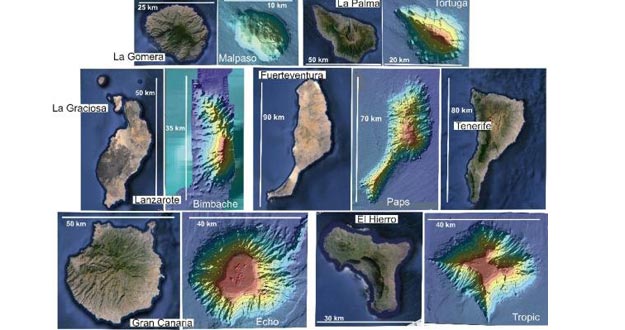Today, I should like to show you another news about Canary Islands: “Eight new seamounts are identified in the southwestern Canary Islands”.
The scientific team of oceanographic campaign, “Drago 0511”, has identified eight new seamounts, in the southwest of Canary, --the largest of them, with the same height of the Teide--, which are ancient islands, that are now sunk, by the cooling effect of the earth's crust.

Image of the eight new mountains in Canary
The discovery of these eight seamounts are added to the five, which were knew until now, in the south of the Canary Islands, and are a kind of "underwater grandmothers" of the islands, almost "a Canary Atlantis", has explained Luis Somoza, marine geologist from the Geological and Mining Institute of Spain (IGME).
Some of these hills "formed islands, now under water, which have plunged more than 300 metres", and therefore "they are the ancestors of the Canary Islands", Somoza tells in detail.
The mountains were identified, by the team of scientists, who conducted the study, to extend the continental shelf of Spain, to the west of the Canary Islands, and the discoveries have taken place after five years of “detailed mapping expeditions" of the canaries deep seabeds.
This discovery shows this area, to the southwest of the islands, is a natural extension of the land territory of the Canary Islands.
The top of the seamounts is from 4,000 meters to 300 meters, under water, and the geologist insists that they are ancient Canary Islands, now sunken, by effect of cooling of the earth's crust.
In some cases, their shape resembles the current of the islands of Tenerife, La Gomera and El Hierro and, according to the data of bathymetry, the largest seamounts are between 90 and 35 kilometers long, and the smallest, between 6 and 20 .
These ancient islands are risen over 3,500 meters, above the surrounding plains deep and as Somoza detailed: "from deep funds would be similar to how we see the Teide from the coast".
Seamounts are formed by the same process as the Canary islands, ie, due to a "hot spot", under the islands, that generate by partial melting of rocks of the Earth's mantle and leads to rise of magma ocean bottom deep.
"It is similar to what can happen to "a soufflé" , if we pulled out of the oven quickly", says Luis Somoza, who also points out that "this does not mean that the Canary Islands to sink immediately", although it they do with the geological time.
"It will take millions of years and, if the 'hot spot', that has made them, moves or disappears, then they will gradually sinking themselves, like their predecessors, these seamounts", he explains.
Furthermore, sea action will progressively "making up" the tops of the islands and the end "our future descendants will see a satin Teide or the boiler Taburiente, plain. But this will happen within millions of years".
Also, continues the researcher, scientists hypothesize that, having the same nature, these seamounts than their descendants, the Canary Islands, it is shown that this area is the submerged natural extension of the archipelago, for the purpose of extending the continental shelf Spanish law.
Luis Somoza added that the scientific team has sent, to the International Hydrographic Commission, proposals for eight names, eminently canaries seamounts, as they are: Drago, Bimbache, Ico, Pelicar, Malpaso, Turtle and Infinity, and The Grandmothers.
The names of the five seamounts, known until now, were given by their English discoverers and they are: The Daughters, Echo, The Paps, Drago and Tropic.
Luis Somoza also indicates that there have been six scientific expeditions, in the vicinity of the canaries deep sea aboard the oceanographic ships, Hesperides, Sarmiento de Gamboa and Miguel Oliver.
The scientific team was made up of researchers, from the Marine Geology of the Geological Survey of Spain, the Spanish Institute of Oceanography and Marine Hydrographic Institute.
Well, I did not know this news and I think it is so curious. Do not you think the same?.
Until my next post, kind regards,
Luis.
Sponsored by Costaluz Lawyers.
Please click below:
